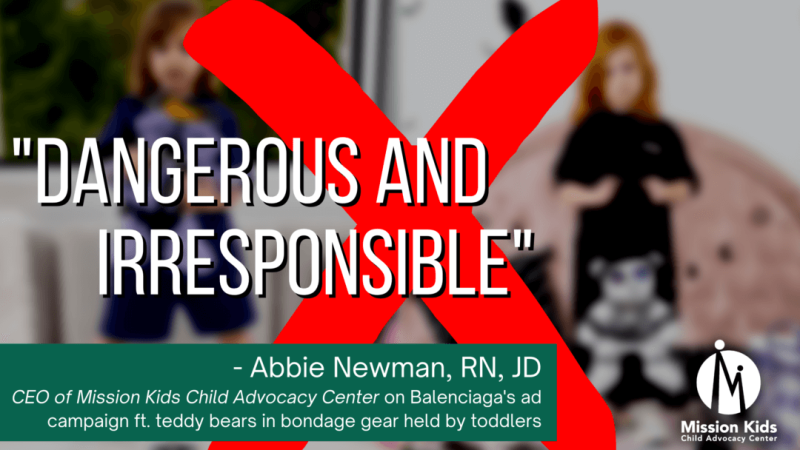Sex sells, and it’s clear that was Balenciaga’s only priority in their spring ‘23 campaign – even if it means the sexualization and endangerment of children.
In a since-removed ad campaign released earlier this week, luxury clothing brand Balenciaga featured female toddlers posed on beds and couches, holding a horrifying product featured in their new line: a teddy-bear-shaped purse dressed in leather bondage gear. Casually placed atop the bed, the floor and along the tables are red, black and chrome-colored props including candle sticks, cans of beer, a studded dog bowl, wine glasses and a leash. In the background, you’ll find more traditional elements of an innocent child’s room like stuffed animals and pastel-colored building blocks.
The contradiction is obvious, the message is clear, and we must not tolerate it.
This is more than a fashion faux pas. Balenciaga’s actions are dangerous and irresponsible. Aside from the profoundly poor judgment of featuring toddlers in a wildly inappropriate and sexualized photoshoot, this product and campaign send a message to children that would essentially save child abusers steps in the grooming process.
We know that 90% of child sexual abuse victims know their abuser, and this ad campaign nearly writes the scripts for grooming.
Let’s picture a vulnerable child in a scenario with an adult that they know and trust. Now add in the images from this campaign, or worse – the product itself – and think of where that can lead. “It’s okay for your teddy bear to do it, so it’s okay for you, too.” It’s beyond disturbing.
At Mission Kids Child Advocacy Center, each child who visits our center – an alleged victim of child abuse – is sent home with a teddy bear. The teddy bear is seen by our children as a symbol of comfort and hope, so much so that they often ask if they can take one home for their siblings, too. Balenciaga’s marketing strategy takes an item known to symbolize innocence and safety to a child and warps it into a normalized, sexual object, ripe for abusers to exploit.
Another since-deleted photo on the Balenciaga website featured a handbag on a desk with a portion of a page from a Supreme Court case, Ashcroft v Free Speech Coalition. In the 2002 case, the court struck down a portion of the Child Pornography Prevention Act (CPPA) of 1996, deciding that virtual child sexual abuse material* is protected speech.
*Note, I very intentionally did not refer to this as “child pornography”, rather as “child sexual abuse material”, and that is an important conversation for another article.
Balenciaga issued a blanket apology on their Instagram story taking some accountability but alluded to blame-shifting by saying they “are taking legal action against the parties responsible for creating the set and including unapproved items” concerning the court document photos. Photographers involved have done nothing but point fingers. According to Newsweek, one photographer stated, “I suspect that any person prone to pedophilia searches on the web and has unfortunately a too easy access to images completely different than mine, absolutely explicit in their awful content. Lynchings like these are addressed against wrong targets, and distract from the real problem, and criminals.”
There are multiple times someone could have intervened: Balenciaga, the ad agency, modeling agency, photographer, assistants, copywriters, stylists, editors, agents, and even the children’s caregivers. This lack of action highlights the need for greater bystander intervention. Why did no one step in?
As child advocates, we condemn this behavior and call on all responsible parties to do more. As responsible adults, we all must take accountability and intervene when someone crosses a line with a child.
If we don’t speak up for children, who will?









